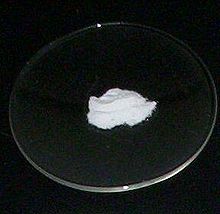Caesium fluoride

| |

| |
| Names | |
|---|---|
| IUPAC name
Caesium fluoride
| |
| Other names
Cesium fluoride
| |
| Identifiers | |
3D model (JSmol)
|
|
| ChemSpider | |
| ECHA InfoCard | 100.033.156 |
| RTECS number |
|
CompTox Dashboard (EPA)
|
|
| |
| |
| Properties | |
| CsF | |
| Molar mass | 151.90 g/mol |
| Appearance | white crystalline solid |
| Density | 4.115 g/cm3 |
| Melting point | 682 °C (955 K) |
| Boiling point | 1251 °C (1524 K) |
| 367 g/100 ml (18 °C) | |
| Structure | |
| cubic, cF8 | |
| Fm3m, No. 225 | |
| Octahedral | |
| 7.9 D | |
| Hazards | |
| Flash point | Non-flammable |
| Related compounds | |
Other anions
|
Caesium chloride Caesium bromide Caesium iodide Caesium astatide |
Other cations
|
Lithium fluoride Sodium fluoride Potassium fluoride Rubidium fluoride |
Except where otherwise noted, data are given for materials in their standard state (at 25 °C [77 °F], 100 kPa).
| |
Caesium fluoride (cesium fluoride in North America), is an inorganic compound usually encountered as a hygroscopic white solid. It is used in organic synthesis as a source of the fluoride anion. Caesium has the lowest electronegativity of all non-radioactive elements and fluorine has the highest electronegativity of all elements.
Synthesis and properties
Caesium fluoride is prepared by the action of hydrofluoric acid on caesium hydroxide or caesium carbonate, followed by removal of water. In addition, elemental fluorine and caesium can be used to form caesium fluoride as well, but doing so is very impractical.[1]
It is more soluble than sodium fluoride or potassium fluoride. It is available in anhydrous form, and if water has been absorbed it is easy to dry by heating at 100 °C for two hours in vacuo.[2]
CsF reaches a vapor pressure of 1 kilopascal at 825 °C, 10 kPa at 999 °C, and 100 kPa at 1249 °C.[3]
Structure
Caesium fluoride has the halite structure, which means that the Cs+ and F− pack in a cubic closest packed array as do Na+ and Cl− in sodium chloride.[4][5]
Applications in organic synthesis
Being highly dissociated it is a more reactive source of fluoride than related salts. CsF is less hygroscopic alternative to tetra-n-butylammonium fluoride (TBAF) and TAS-fluoride (TASF) when anhydrous "naked" fluoride ion is needed.
As a base
As with other soluble fluorides, CsF is moderately basic, because HF is a weak acid. The low nucleophilicity of fluoride means it can be a useful base in organic chemistry.[4] CsF gives higher yields in Knoevenagel condensation reactions than KF or NaF.[6]
Formation of C-F bonds
Caesium fluoride is also a popular source of fluoride in organofluorine chemistry. For example, CsF reacts with hexafluoroacetone to form a caesium perfluoroalkoxide salt, which is stable up to 60 °C, unlike the corresponding sodium or potassium salt. It will convert electron-deficient aryl chlorides to aryl fluorides (halex reaction).[7]
Deprotection agent
Due to the strength of the Si–F bond, fluoride ion is useful for desilylation reactions (removal of Si groups) in organic chemistry; caesium fluoride is an excellent source of anhydrous fluoride for such reactions. Removal of silicon groups (desilylation) is a major application for CsF in the laboratory, as its anhydrous nature allows clean formation of water-sensitive intermediates. Solutions of caesium fluoride in THF or DMF attack a wide variety of organosilicon compounds to produce an organosilicon fluoride and a carbanion, which can then react with electrophiles,[5] for example:[6]
Desilylation is also useful for the removal of silyl protecting groups.[8]
Other uses
Single crystals of the salt are transparent into the deep infrared. For this reason it is sometimes used as the windows of cells used for infrared spectroscopy.
Precautions
Like other soluble fluorides, CsF is moderately toxic.[9] Contact with acid should be avoided, as this forms highly toxic/corrosive hydrofluoric acid. The caesium ion (Cs+) and caesium chloride are generally not considered toxic.[10]
References
- ^ http://www.youtube.com/watch?v=TLOFaWdPxB0 Reacting Fluorine with Caesium
- ^ Friestad, G. K.; Branchaud, B. P. (1999). Reich, H. J.; Rigby, J. H. (ed.). Handbook of Reagents for Organic Synthesis: Acidic and Basic Reagents. New York: Wiley. pp. 99–103.
{{cite book}}: CS1 maint: multiple names: authors list (link) - ^ http://www.physics.nyu.edu/kentlab/How_to/ChemicalInfo/VaporPressure/morepressure.pdf 6-63
- ^ a b Greenwood, N.N.; Earnshaw, A. Chemistry of the Elements, Pergamon Press, Oxford, UK, 1984.
- ^ a b Lide, D. R., ed. (2005). CRC Handbook of Chemistry and Physics (86th ed.). Boca Raton (FL): CRC Press. ISBN 0-8493-0486-5.
- ^ a b Fiorenza, M; Mordini, A; Papaleo, S; Pastorelli, S; Ricci, A (1985). "Fluoride ion induced reactions of organosilanes: the preparation of mono and dicarbonyl compounds from β-ketosilanes". Tetrahedron Letters. 26 (6): 787. doi:10.1016/S0040-4039(00)89137-6.
- ^ F. W. Evans, M. H. Litt, A. M. Weidler-Kubanek, F. P. Avonda (1968). "Reactions Catalyzed by Potassium Fluoride. 111. The Knoevenagel Reaction". Journal of Organic Chemistry. 33 (5): 1837–1839. doi:10.1021/jo01269a028.
{{cite journal}}: CS1 maint: multiple names: authors list (link) - ^ Adam P. Smith, Jaydeep J. S. Lamba, and Cassandra L. Fraser (2002). "Efficient Synthesis of Halomethyl-2,2'-bipyridines: 4,4'-Bis(chloromethyl)-2,2'-bipyridine". Organic Syntheses. 78: 82
{{cite journal}}: CS1 maint: multiple names: authors list (link); Collected Volumes, vol. 10, p. 107. - ^ MSDS Listing for cesium fluoride. www.hazard.com. MSDS Date: April 27, 1993. Retrieved on September 7, 2007.
- ^ "MSDS Listing for cesium chloride." www.jtbaker.com. MSDS Date: January 16, 2006. Retrieved on September 7, 2007.
External links

